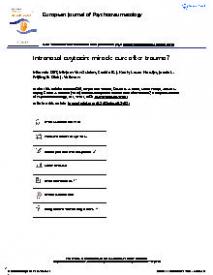Intranasal oxytocin : miracle cure after trauma?
Background: In popular media and on Internet, the neuropeptide oxytocin is often advertised as a miracle drug that cures all
types of disorders, reduces stress, saves marriages, all conveniently with a nasal spray. Here we will present the effects of intranasal
oxytocin on brain function in recently traumatized individuals and patients with posttraumatic stress disorder (PTSD) and
discuss clinical implications and further research. PTSD is characterized by exaggerated fear responses to threat and traumarelated
stimuli, reflected in altered neural salience processing and emotion regulation (Koch et al., 2014). In addition, many
PTSD patients report anhedonia, emotional numbing, and social detachment, reflected in decreased reward sensitivity (Nawijn
et al., 2015). Interestingly, dysregulations in these domains also appear to be associated with increased PTSD risk upon trauma
exposure and treatment non-response. Currently, there still is a high need for development of effective preventive interventions
for PTSD, that can be administered early after trauma, as well as a need for novel adjuvant interventions that augment treatment
response to evidence-based psychotherapy for PTSD (i.e., medication-enhanced psychotherapy [MEP]) (see also Hendriks &
De Kleine, 2015).
In: European Journal of Psychotraumatology, ISSN 2000-8066 | 6 | 1 | 27631
http://dx.doi.org/10.3402/ejpt.v6.27631


